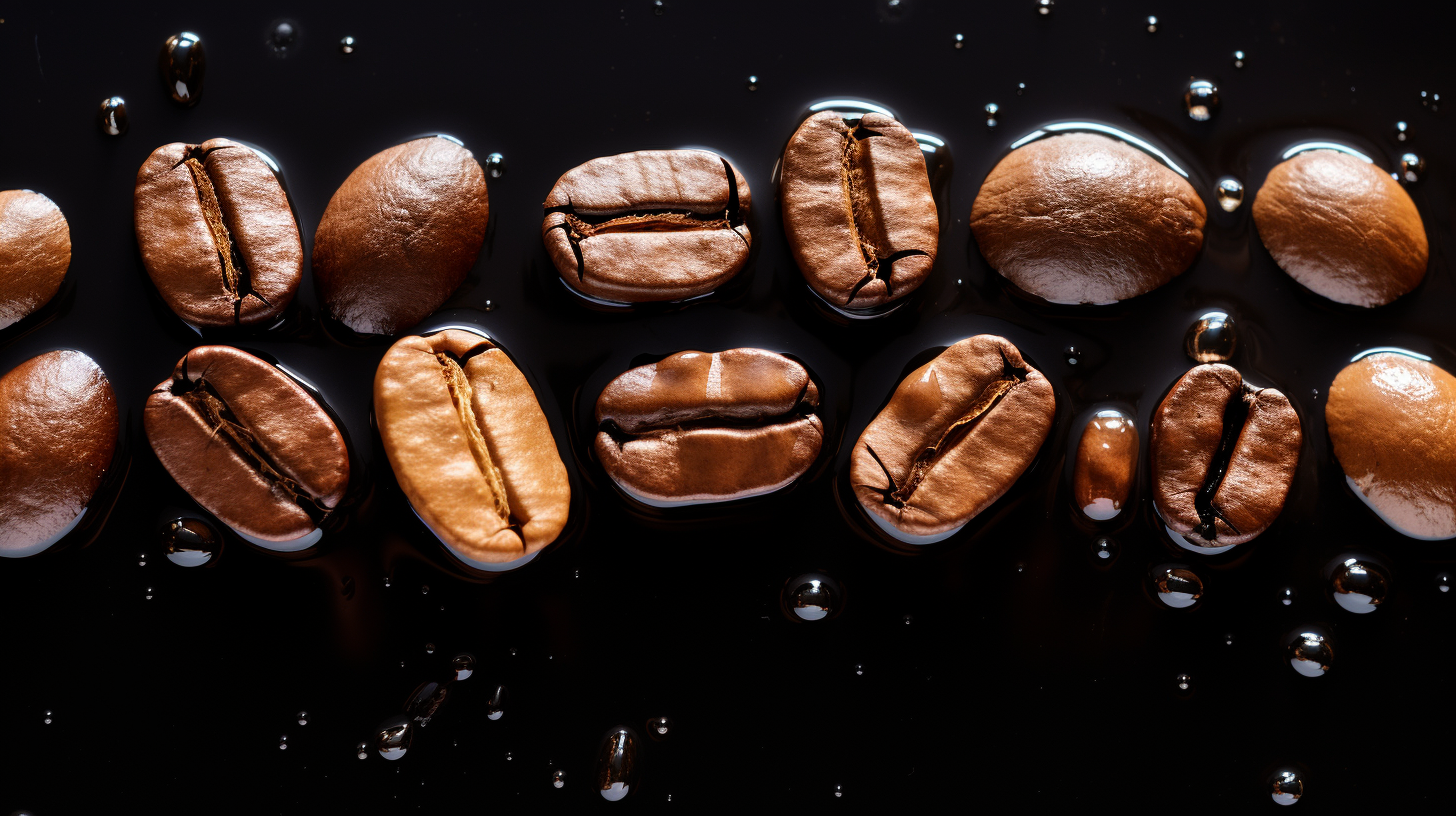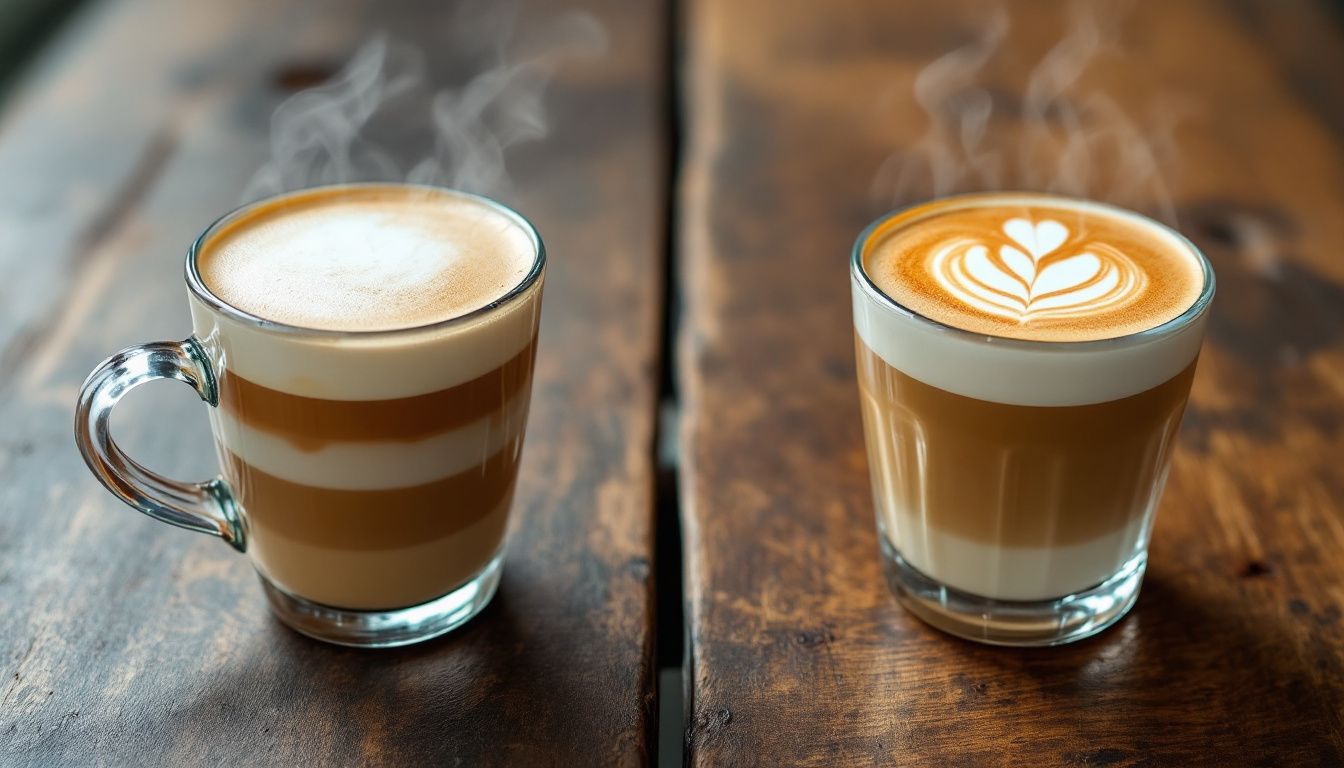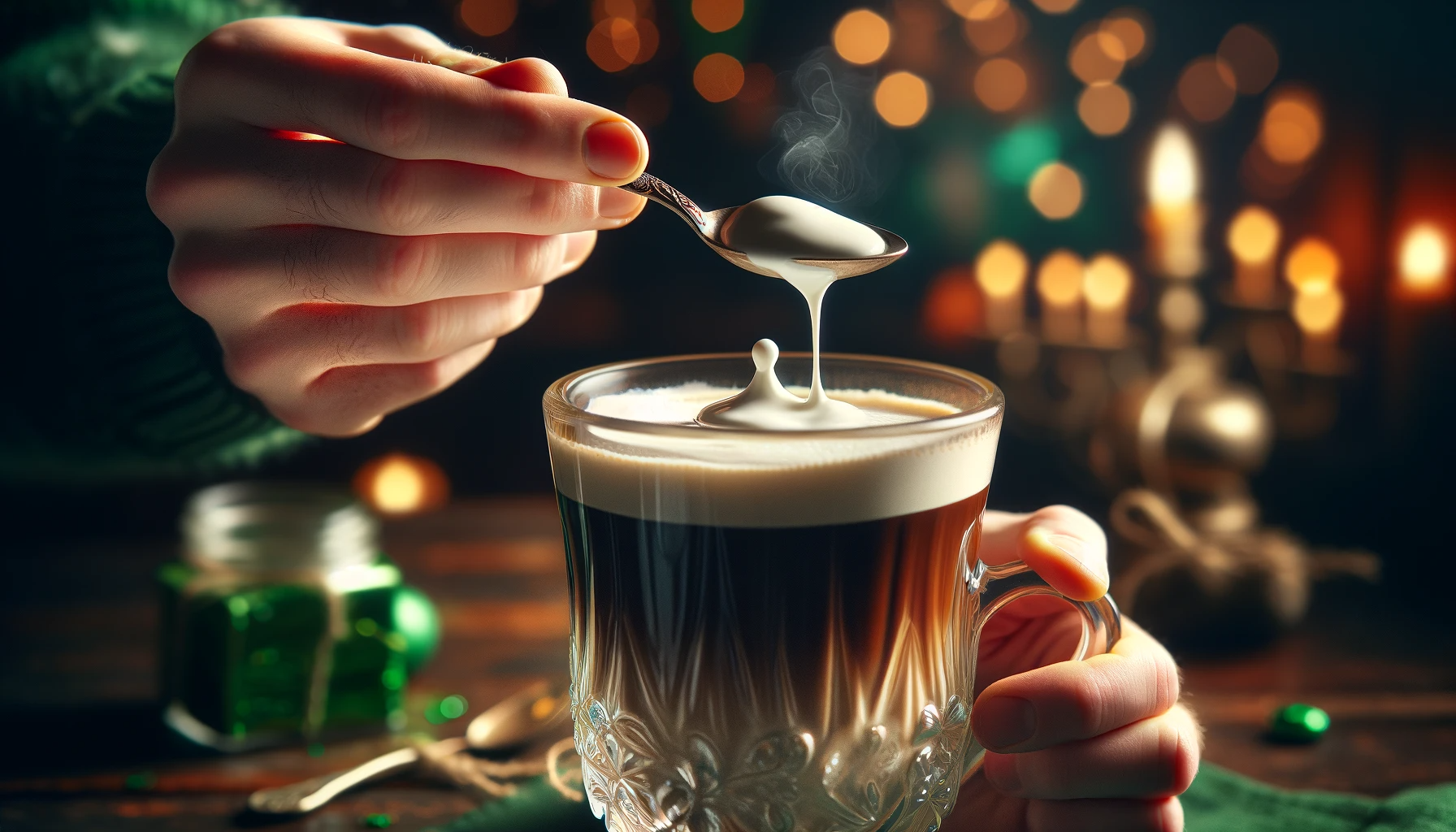Blog
Cortado Vs Latte: A Comprehensive Guide To Your Favorite Espresso Drinks
Deciding between Cortado and Latte can be challenging. Both are distinguished espresso drinks with their own flavours and textures. You might be pondering which one aligns best with your coffee preferences.
Here’s a piece of information: A Cortado, originating from Spain, provides a balanced blend of espresso and steamed milk, while a Latte, coming from Italy, pleases with more steamed milk overlying its espresso base.
This article will assist you in understanding the dissimilarities between a Cortado and a Latte. We’ll study their origins, their preparation methods, and their individual flavours.
At the conclusion, you’ll identify which drink suits you best, based on the intensity of taste and caffeine content. Ready to discover your favourite?

What Is a Cortado?
A Cortado is a smooth coffee mix from Spain. It blends equal parts of espresso and warm milk to cut the acid, making every sip just right.
Origin and History of the Cortado
The cortado comes from Spain’s Basque region. It got its name from the Spanish verb “cortar,” which means to cut. The idea was to cut through the strong taste of espresso with a little milk.
This drink became popular all over the world in the late 20th century.
In the United States, Steve Ford from Blue Bottle Coffee made a similar drink known as the Gibraltar more famous. Like a cortado, it mixes espresso with just a bit of steamed milk for balance.
People love it in coffee shops everywhere now.
Cortado Ingredients and Preparation Method
A cortado blends espresso with steamed milk for a smooth coffee. It takes about 3 minutes to make one. Here’s how:
- Gather your ingredients: You need finely ground coffee and whole milk.
- Use an espresso maker to brew a strong coffee shot.
- Heat the milk using a milk frother until it’s steamy but not too frothy.
- Mix equal parts of espresso and steamed milk in a small mug or Gibraltar glass.
- For different tastes, try adding sweetened condensed milk for a cortadito, syrup for flavour, chilled milk for an iced version, or plant-based milk for a vegan drink.
Making a cortado is simple and offers many ways to enjoy your coffee.

What Is a Latte?
A latte is a popular coffee drink made with espresso and lots of steamed milk. It started in Italy and has become loved around the world for its creamy texture and mild coffee taste.
Origin and History of the Latte
In Italy, they call it caffè latte, which means milk coffee. This drink found its way to the US in the 1980s and quickly became a favourite. It’s made with espresso and lots of steamed milk.
The latte got popular because people loved its smooth taste.
Coffee shops everywhere started making lattes. They use machines to mix hot water with finely ground coffee beans to make espresso. Then they add steamed milk to make it creamy. Some even create art on top with the foam from the milk.
This is how lattes became known all over as a special coffee drink that blends rich flavours with lovely designs.
Latte Ingredients and Preparation Method
A latte is a coffee concoction composed of espresso and hot milk, adored by many individuals for its lush texture and profound taste. Here’s how you can prepare one:
- Initiate with 1-2 ounces of espresso. This is your drink’s coffee foundation.
- Warm 8-15 ounces of milk to 135-150 degrees Fahrenheit. This warms the milk without causing it to boil.
- Whip the hot milk until it produces a slick, velvety microfoam.
- Ladle the hot milk over the espresso in a large cup. Go for a proportion that favours more milk than coffee.
- If you wish, sculpt latte art on top by pouring the milk so that it crafts patterns.
- For a chilled variant, utilise cold milk in lieu of hot and serve over ice.
The process of making a latte necessitates an espresso machine or comparable coffee maker and a tool for frothing the milk such as a steam wand. Keep in mind, repetition perfects skills, especially when adjusting the mix of tastes correctly and perfecting latte art!
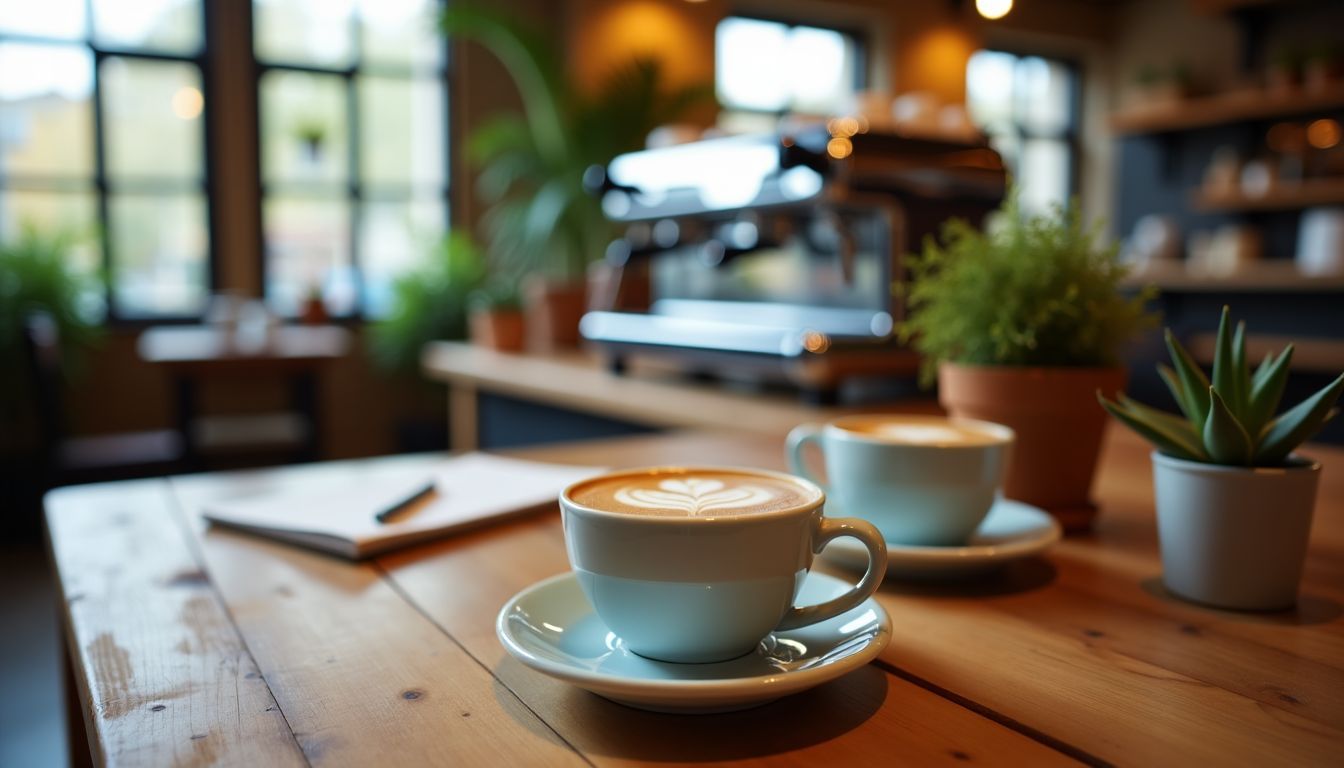
How Do the Milk Ratios Differ Between a Cortado and a Latte?
In a cortado, the amount of milk and espresso is equal. But in a latte, there’s much more milk than espresso.
Milk to Espresso Ratio in a Cortado
In a cortado, the mix of milk to coffee is quite specific. You get equal parts espresso and steamed milk. This means if you have one shot of espresso, you’ll add the same amount of milk.
Usually, this ratio falls between 1:1 and 1:2. So, if it’s not exactly equal, there might be just a tiny bit more coffee than milk.
This balance makes sure the strong taste of espresso stays at the front but smoother from the milk. Compared to other drinks like lattes or cappuccinos, cortados let you enjoy deep coffee flavors without too much milk diluting them.
It’s perfect for when you want something strong yet gentle on your palate.
Milk to Espresso Ratio in a Latte
A latte mixes one part espresso with three parts steamed milk. This ratio makes the drink creamier and milder in taste than others, like a cortado. The more milk means you can enjoy the sweetness and mouthfeel without a strong coffee flavour taking over.
Baristas often top it with a small amount of foam for that classic look we all know. So, when you sip a latte, you’re getting less espresso punch and more smooth milk in every cup.
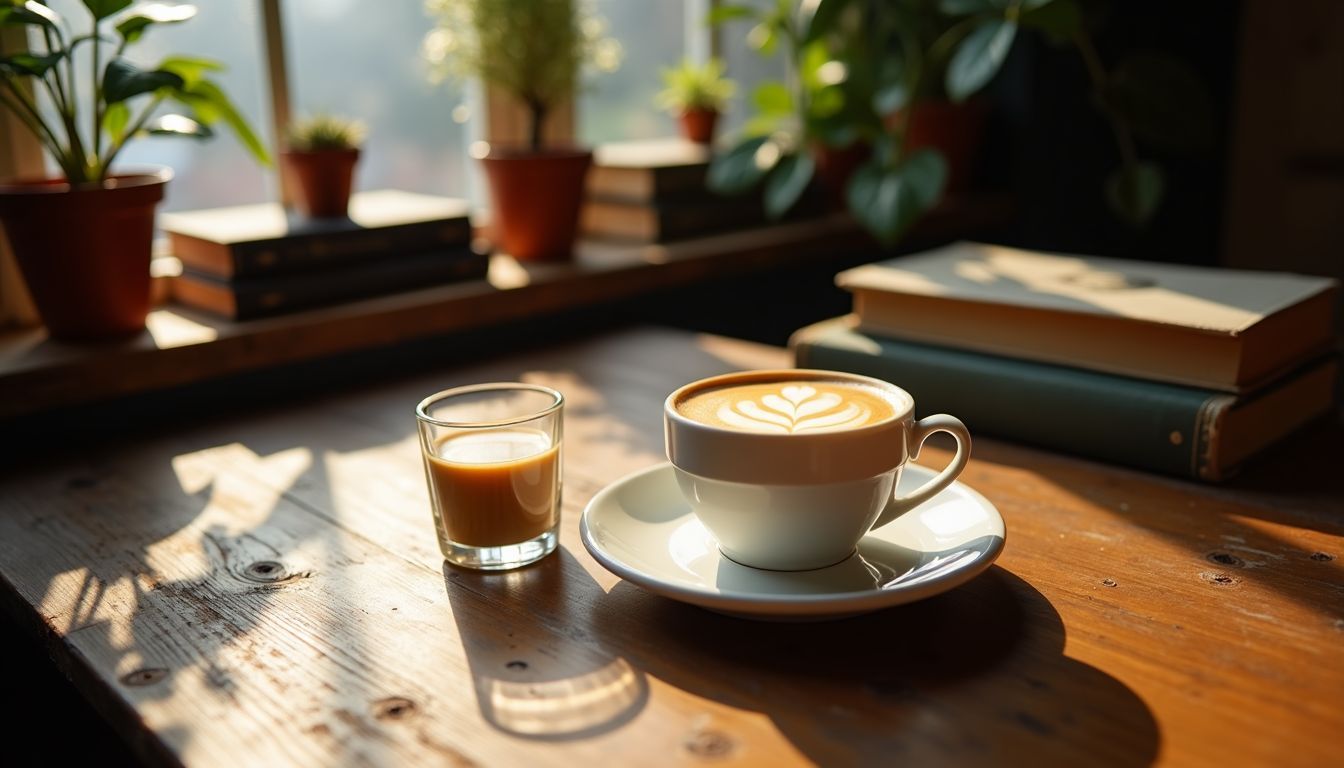
How Does the Serving Size Compare Between a Cortado and a Latte?
A cortado is much smaller, usually served in a 150ml glass. On the other hand, a latte comes in a bigger cup of about 240 to 480ml.
Typical Serving Size of a Cortado
A cortado comes in small, compact glasses. This size is perfect for a strong coffee taste. It focuses more on the espresso while keeping milk to a minimum. You get about 60-90 ml of this rich coffee drink.
This makes it ideal if you love concentrated coffee experiences without much milk. In many coffee shops, a cortado is often smaller than a latte or flat white. This serving size will give you an intense flavour in each sip.
Typical Serving Size of a Latte
A latte comes in a 10 oz glass. This makes it larger than cortados. You’ll get more drink in a single order of a latte. Coffee shops around the world serve lattes this way, making them a popular choice if you want something bigger to sip on.
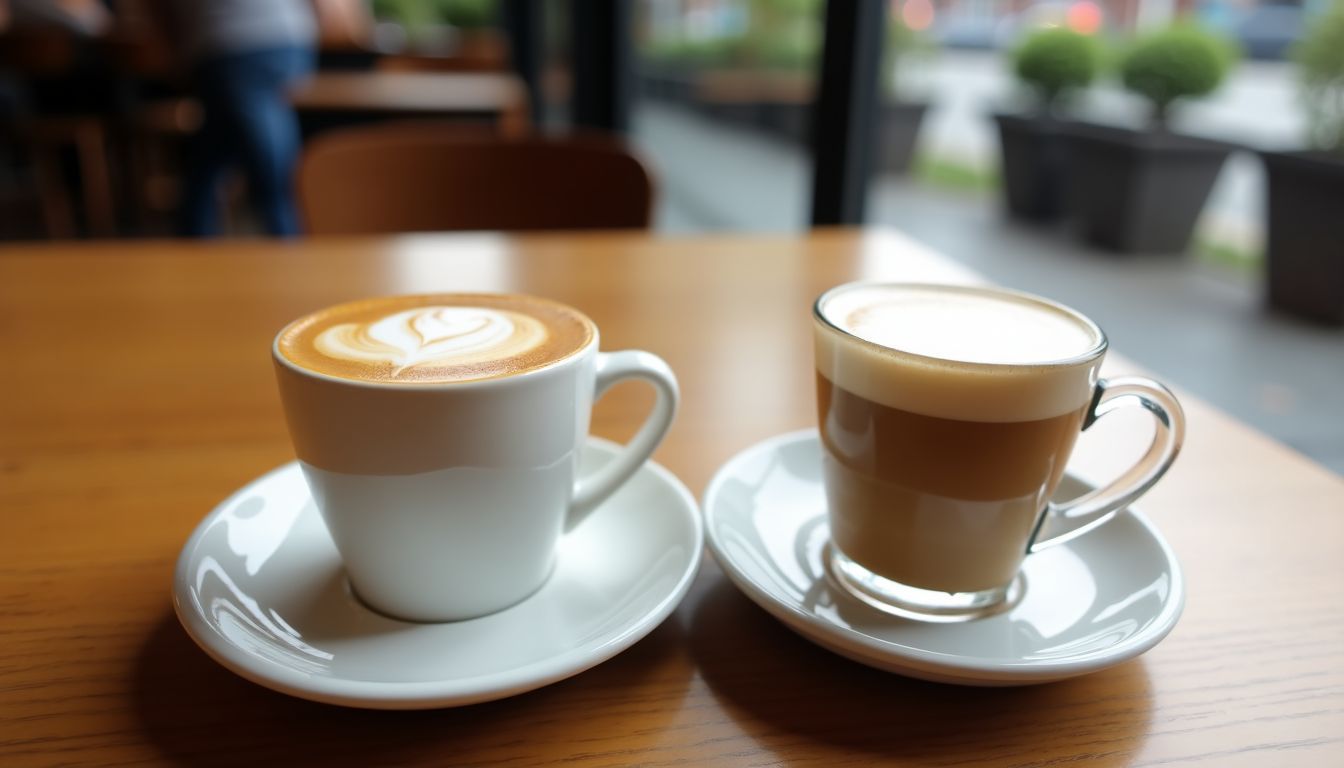
How Do the Flavours of a Cortado and a Latte Contrast?
A cortado brings out strong coffee tastes, thanks to less milk. In contrast, a latte’s flavor is milder and creamier because it has more milk.
Flavour Profile of a Cortado
A cortado mixes equal parts of espresso and steamed milk. This gives it a strong coffee taste. The drink has little to no foam, which makes the coffee flavour stand out more. People serve it in small glasses to show off its concentrated taste better.
Because of the equal mix of espresso and milk, a cortado has a higher caffeine level than some other drinks.
Flavour Profile of a Latte
A latte mixes milk and espresso in a 1:3 ratio. This blend makes the drink sweet and creamy. The milk reduces the bitterness of the espresso, making it perfect for a gentle start to your day.
Enjoying a latte means experiencing a smoother coffee taste, where the strong espresso notes are balanced with rich milkiness. It’s an ideal choice if you prefer your morning coffee milder yet flavourful.

Which Drink Has More Caffeine: Cortado or Latte?
A cortado and a latte both start with espresso. But, the amount of milk added changes their caffeine kick.
Caffeine Content in a Cortado
A cortado has espresso and a little milk. It comes in 4-ounce glasses. This size means every sip packs more caffeine than larger drinks with the same amount of espresso. So, you get a strong coffee taste.
This drink’s higher espresso-to-milk ratio also makes the caffeine seem stronger. If you like your coffee with a robust flavour, this is for sure your cup of choice.
Caffeine Content in a Latte
A latte comes with one or two shots of espresso. This means you get the same amount of caffeine in a latte as you do in a cortado. Both drinks will wake you up in the morning or keep you going during a long day.
Since lattes have more milk, the strong coffee taste might feel milder. But don’t worry, the caffeine is still there doing its job.

Which Should You Choose: Cortado or Latte?
Choosing between a cortado and a latte comes down to two main things: how strong you like your coffee and what size of drink you prefer. If intense coffee flavour with less milk sounds good, go for a cortado.
If you enjoy more steamed milk in your cup, then a latte is the way to go.
Preferences Based on Taste and Strength
You love strong coffee? Go for a cortado. It mixes equal parts espresso and milk. This drink shows off the coffee’s rich flavor without much foam getting in the way. If creamy texture and mild taste sound better to you, choose a latte instead.
A latte has more milk, six times as much as its espresso, which makes it softer on your palate.
Your choice depends on what you like in a coffee drink. For an intense espresso hit with balanced milk, pick a cortado from your local coffee shop. Or maybe you’re in the mood for something less bold but still delightful; then a latte is your match, offering gentle sips under layers of foamed milk perfect for those lovely latte art designs we all admire.
Best Occasions for Each Drink
Cortados and lattes, each has its own perfect time and place. Selecting the right one is a matter of the hour and what you desire from your coffee experience.
- A cortado can be enjoyed as a mid-morning energy source. Cortados, balancing espresso and milk in equal parts, present a potent coffee flavour that’s just right for a brisk energy lift.
- Lattes are brilliant for relaxed mornings or afternoons. With a higher milk-to-espresso ratio, they propose a gentler coffee taste ideal for unhurried sipping while immersed in a book or engaging in conversation with friends.
- Cortados blend well into brief work interruptions. Their compact size means you can consume them swiftly and return to work invigorated.
- A latte is just right for coffee get-togethers. Their increased size and softer flavour make them pleasant to sip during extended chats.
- If you’re experimenting with new flavours, a latte is a good starting point. The surplus milk moderates the espresso’s acidity, permitting you to discern added flavours like vanilla or caramel more easily.
- Pick a cortado when you wish to appreciate the true tastes of the coffee. The reduced milk content allows the authentic qualities of the coffee to be prominent.
- Lattes act well as an afternoon indulgence due to their adaptability in flavours and the choice for intricate latte art designs.
- Lattes are fitting for those who like their caffeine in moderate amounts throughout the day because of their generous size and lower coffee concentration.
- Cortados are best savoured during hectic days when time is scarce but the craving for powerful coffee is significant.
- Lastly, if you are fond of delving into European coffee traditions, opt for a cortado at any time of day to value its minimal yet potent personality.
So, be it having a brief break with a piquant cortado or unwinding with a smooth latte, each drink suits a perfect moment that caters to your present mood or activity.
Conclusion
You now know the key facts about cortado and latte. Cortados come from Spain, with equal parts espresso and milk. Lattes trace back to Italy and have more milk than a cortado. This affects their taste, size, and caffeine kick.
A cortado is smaller but offers strong coffee flavour. Latte is larger, milder, and can show off fancy milk art.
Feeling curious? Try making both drinks at home! You’ll see which you prefer based on taste or the time of day. If you enjoy strong coffee flavour without much milk, go for a cortado.
Love your coffee milky? Choose a latte instead.
It’s great fun to play barista in your kitchen. Experimenting will make you appreciate how steam wands work on different drinks’ textures.
So grab your espresso machine next weekend… And start exploring these delicious options!
FAQs
1. What’s the difference between a cortado and a latte?
A cortado is an espresso-based drink with a balance of strong coffee and milk, typically offering a robust coffee flavour compared to a latte. A latte contains more milk, giving it milder coffee notes.
2. How does the ratio of espresso to milk differ in these drinks?
In both beverages, the ratio of espresso to milk plays a key role in their taste. A cortado typically has an equal ratio of espresso to steamed milk, resulting in stronger coffee taste whereas lattes have higher proportions of steam milk which gives them creamier texture.
3. Where do piccolo latte and cortado originate from?
The piccolo latte hails from Italy while origins of the Cortado can be traced back to Spain. Both are now staples in coffee shops worldwide due to their popularity among coffee enthusiasts.
4. Is there any similarity between Piccolo Latte vs Cortado or Latte vs Flat White?
Yes! All three types are similar as they all contain double shots of espresso but vary depending on ratios of milk added – creating different experiences for every coffee lover out there.
5. Can I create intricate latte art designs with these drinks?
Indeed you can! The amount and preparation method for the steam milk used in lattes especially allows baristas to create artistic designs on top making your favourite cuppa not only tasty but visually appealing too!
6. Are these drinks popular choices at Coffeehouses worldwide?
Absolutely! Drinks like Cortados and Lattes have become staples at Coffeehouses globally because they offer unique flavours that cater to both those who prefer stronger or milder coffees.

